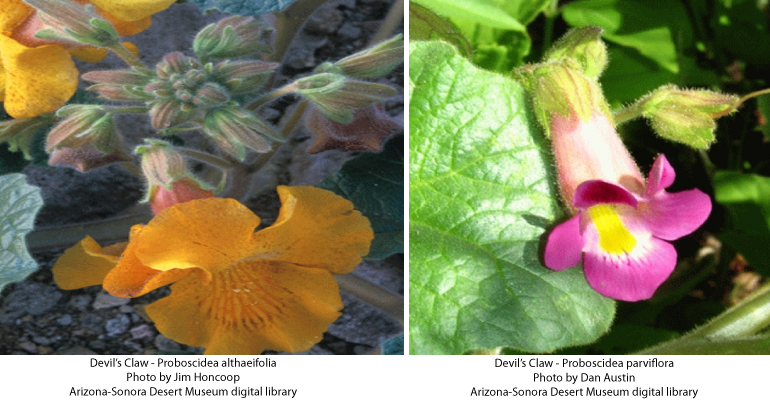
Devil’s Claw (also called the unicorn plant) provides food, fiber, and medicine to native people of the Sonoran Desert. Devil’s Claw can be found on plains, mesas, and along roads from western Texas, to southern Nevada, Arizona, southern California, and in northern Mexico.
There are two species in Arizona: Proboscidea parviflora has white to pink flowers and Proboscidea althaeifolia has yellow flowers. The flowers are about one inch wide. The plant grows to about two feet high and up to six feet wide. The foliage is sticky and bad-smelling.
Young, tender pods can be boiled for food and have the consistency and taste of okra. Dried seeds can be eaten raw or crushed into mush.
The roots were used as a treatment for arthritis and consider by some to be a good liver tonic.
The outer covering of the pods turns black when dry. Both the Pimas and Tohono O’odham use the fibers to make the black designs in their basketry.
According to the Arizona-Sonora Desert Museum:
“The variety hohokamiana is a cultivar developed by the O’odham. It differs from the wild type in two important ways. The cultivar has claws up to a foot (30 cm) long with softer fibers. The black fibers in the claws are used in basket-making, especially by the Tohono O’odham. The longer, softer fiber in the domesticated claws are easier to work with. Secondly, the seeds of the cultivar are white instead of black, and lack germination inhibitors. While seeds of the wild type must lie in the ground for a couple of years before they will germinate, the white seeds sprout as soon as they get wet in hot weather and are thus easier to cultivate. This is one of the few plants domesticated north of Mexico, and this seems to have been accomplished only late in the last century. There is a theory that the introduction of cattle was the catalyst. Cattle will eat devil’s claw plants, and O’odham women may have been forced to save seeds and grow them in more protected areas than previously. Among the saved seeds was a variant with longer claws and white seeds. The cultivar is now grown by more than 25 native cultures, some of whom live far beyond the natural range of the wild devil’s claw.”
See more ADI article on desert plants:
Agaves provide food, fiber and adult beverages
Cactus water will make you sick
Chiltepin peppers, spice and medicine
Desert Broom – another medicinal plant
Desert Tobacco, a Pretty but Poisonous Desert Plant
Guayacán a pretty flowering tree
Invasion of the Popcorn Flowers
Joshua Trees of the Mohave Desert
Medusa’s Head a strange and useful plant
Mesquite trees provide food, fuel, medicine, and more
Oak trees of the Sonoran Desert region
Ocotillo – an aide to hummingbirds and geologists
Palo brea trees and their uses
Palo Verde trees about to turn the desert golden
Sacred Datura – pretty, poisonous, and hallucinogenic
Saguaro Cactus Icon of the Sonoran Desert
Spectacular flowers of the red Torch Cactus

